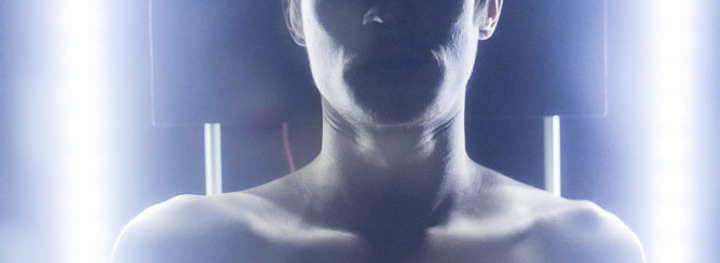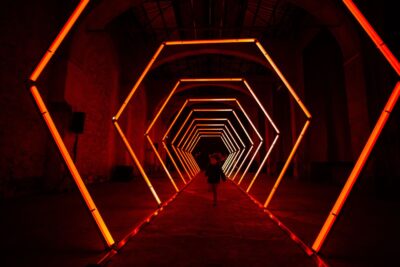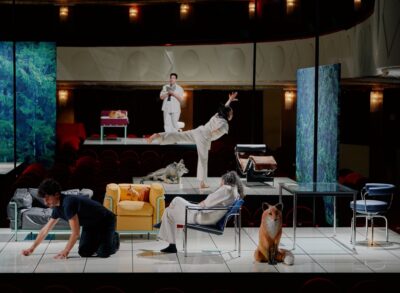“Nigredo combines some things only the best artworks can do : It uses newest science and technology to create an intimate response, it is still very emotional and physical, and it is definitely an unforgettable experience.”
Alain Bieber, Art Critic, ARTE Creative
Nigredo
Nigredo (2013) is a private experience of altered self-perception and biophysical media. Developed at STEIM, in collaboration with artist and engineer Marije Baalman, the work is a private eight-minute artwork to be experienced by one visitor at a time. It is presented in the form of a time-based installation.
Accompanied by an assistant, a visitor enters a very small and completely blackened booth. Here the visitor is invited to sit on a chair facing a one-way mirror. The chair is embedded with three high-power infrasound devices that make direct contact with the visitor’s skull and vertebral column. The assistant requests the visitor to take off shoes and shirt, then blocks the skull of the visitor to the chair using an elastic headband and helps the visitor wearing a Xth Sense biosensor at the location nearest to the heart.
The Xth Sense captures the sound of the visitor’s heartbeat, blood flow and muscle contractions. That sound is digitally processed and fed back to the visitor’s body in the form of new audio, visual and physical stimuli. Namely, sounds are diffused by a hidden surround system and two subwoofers, flickering lights are generated by LED strips located behind the visitor’s body, while intense mechanical vibrations are induced to the whole body using the high-power infrasound devices.
Below you can view the project teaser, recorded during the premiere of the work at STEIM (NL) in February 2013.
By making direct contact with the skull and the vertebral column, the infrasound devices feed back to the visitor’s body her own visceral sounds in the form of mechanical vibration patterns. The different patterns are designed so to travel through the body in opposite directions and thus create standing waves inside the visitor’s rib cage. A standing wave is a stationary wave that is produced by the encounter of two waves traveling in opposite directions and so induces resonance into a medium, in this case, a human body.
Because the standing waves is a strong stationary acoustic vibration, it resonates internally the bones and the tissues, and thus displaces the relative position of one’s body organs (Griffin and Seidel, 2011). The combination of intense whole-body vibration, spatialised auditive stimuli and flickering lights interferes with the neurophysiological processes that govern the voluntary and autonomic nervous systems. This alters the rhythm of the cardiovascular and respiratory system, the perception of one’s own articulations in space and the behaviour of the optical nerves (Rejali, 2003). The perception of one’s own image in the mirror mutates and with it also the perception of one’s own body changes.
By repurposing biofeedback methods, whole-body vibration and wearable bioacoustic technology, the visitor is first induced in a state of perceptual deprivation, and then subjected to diverse stimulations designed and temporally composed so to provoke physiological, physical and neural alterations. The work aims to unlock latent qualities of the human body through its coupling with the technological system.
By executing a temporal composition of auditive, light and vibrational stimuli in different combinations and intensities, the system creates a saturated stimulation fields that induces the visitor’s body in a state of perceptual deprivation. In this state, the human body is not able to make meaningful grouping of internal and external stimuli and thus the neurophysiological processes that drive the perception of both the environment and one’s own body are altered (Rasmussen, 2007, pp. 9-11). The aware distinction between what is part of one self and what is seemingly not is blurred.
It is an intimate and uncanny experience of ones inner self. By creating a system that can only function through the co-dependence of a human body and a technological one in a perceptually saturated space, the work aims to forcefully create alternate connections between he constituting parts of the organic and the machinic bodies. The sound of vital and physiological processes of the human body are magnified so to make the latter (literally) resonate with the parts of the technological system. The supposed separation of the individual from living and technological others is put into question.
In other words, by transforming the natural pulsation of the human body into new internal states, the technical system and the human body become active part of a new body, one that integrates them into one emerging entity. The human and the machine bodies become a constituting part of each other. It is an experience that takes place in between viscera and circuits, flesh and sound.
References
– Griffin, M. J. and H. Seidel 2011. Whole-Body Vibration. Available at: http://www.ilo.org/oshenc/part-vi/vibration.
– Rasmussen, J. E. 2007. Man in Isolation and Confinement. Aldline Transaction.
– Rejali, D. 2003. Modern torture as a civic marker: Solving a global anxiety with a new political technology. Journal of Human Rights, 2(2):153–171.
The techniques used in this work are completely safe. Please note however, that the work includes high sound pressure level and strong light pulsations that may not be suitable for all kind of audiences.
Conceptual foundations
The term Nigredo comes originally from alchemy, where it is referred to as putrefaction or decomposition. In order to create the philosopher’s stone, alchemists would produce a homogeneous black matter by slowly cooking all their ingredients at once. Later, in the framework of analytical psychology developed by Carl Jung, the term became a metaphor of the moment of despair and disillusionment caused by an ever deepening descent into the dark unknowns of the subconscious mind. For Jung, the Nigredo is critical to self-realization, as it represents the key to what he calls individuation or, in other words, the psychological process of integrating the conscious with the unconscious.
Awards and production
Nigredo won two international prizes. These are the Cynetart Prize for Computer Based Art 2014 by Cynetart Festival and HELLERAU (DE), and the TransitioMX New Media Art Award 2013 by CENART (MX).
The work was developed during an artistic residency at STEIM, Studio for Electro-Acoustic Music in February 2013. A special acknowledgement goes to Jonathan Reus, Marije Baalman, Nico Bes, and Esther Roschar for their invaluable support during the production and preview of the work. STEIM (the studio for electro-instrumental music) is an independent live electronic music centre unique in its dedicated to the performing arts. STEIM has stimulated the design of extremely physical interfaces and is widely considered as the pioneering place for the new live electronic concepts.
Credits
Concept, composition, and realisation: Marco Donnarumma
Artistic support and hardware engineering: Marije Baalman
Tech support: Lucas Norer
Visitors’ assistant: Ida Toft
Videography: Tanja Busking
Project Keywords
bio, biosensing technologies, body, MMG; self-perception, proprioception, sensory deprivation, otherness; blood, flesh, internal organs, muscle tension; high sound pressure level, pulse light, induced skeletal resonance, whole-body vibration, standing wave; real time, audio and light processing, pure data.
Selected exhibitions
- CYNETART Festival, international festival for computer based art and transdisciplinary media projects, Dresden, DE, 2014
- TransitioMX Biomediation, fifth competition of electronic arts and video, Centro Nacional de las Artes (CENART), Mexico City, 2013
- STEIM, Studio for Electro-Instrumental Music, premiere, Amsterdam, NL, February 2013






